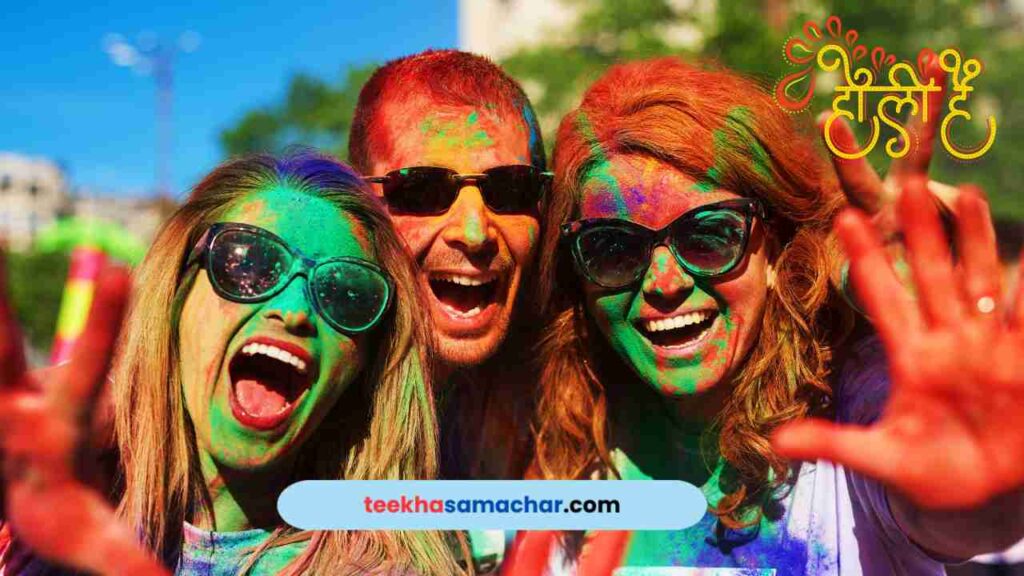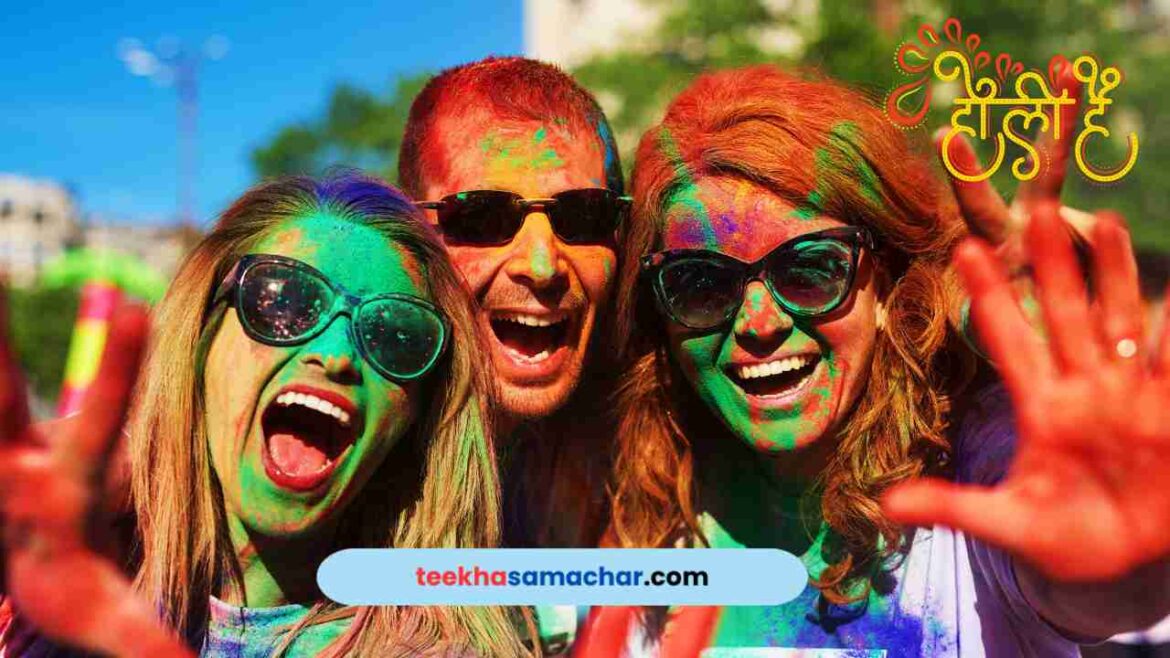Why Holi is Celebrated : Holi, the festival of colors, holds a special place in the hearts of millions across India and around the world. Beyond the vibrant splashes of color and the joyous revelry, Holi is steeped in a rich tapestry of traditions, spirituality, and cultural harmony. In this detailed exploration, we delve into the multifaceted reasons behind the celebration of the Holi festival.
Why Holi is Celebrated : Ancient Roots, Rituals and Traditions

Ancient Roots and Historical Evolution:
Holi’s origins can be traced back to ancient times, rooted in various historical and religious practices. Over the centuries, it has evolved, absorbing influences from different dynasties and regions, shaping the festival into the dynamic and inclusive celebration it is today. The festival’s roots are deeply embedded in the diverse cultural landscape of India, reflecting the country’s rich historical tapestry.
ALSO READ : Holi ki Khoj : Rangon ke Peeche ka Safar – Holi ke Bharatiya Tyohar ki Dilchasp Kahani
Mythological Significance:
The mythological significance of Holi is deeply ingrained in Hindu mythology, particularly the legend of Holika and Prahlada. Prahlada’s unwavering devotion to Lord Vishnu and the subsequent triumph of good over evil during the burning of Holika lay the foundation for the festival. Holi, in essence, symbolizes the victory of righteousness and the cleansing power of fire. The narrative serves as a moral compass, emphasizing the consequences of unwavering faith and the ultimate triumph of good.
Welcoming Spring and Nature’s Renewal:
Holi marks the arrival of spring, a season of renewal, growth, and blossoming life. The festival serves as a joyful farewell to the cold winter months, embracing the vibrancy of spring. The playing with colors mirrors the awakening of nature and the explosion of life after the dormancy of winter. The symbolic connection between the festival and the changing seasons highlights the cyclical nature of life and the continuous process of renewal.
Rituals and Traditions:
The celebration of Holi spans over two days. The first day involves the lighting of bonfires, symbolizing the triumph of virtue over vice, known as Holika Dahan. The second day, Rangwali Holi, is characterized by the playful throwing of colored powders and water. Traditional rituals such as singing folk songs, feasting on special Holi sweets, and offering prayers contribute to the cultural richness of the festivities. These rituals not only add depth to the celebration but also foster a sense of community and shared heritage.
Video :
Cultural Harmony and Social Unity:
Holi transcends social, religious, and cultural boundaries, promoting a sense of unity and equality. The festival encourages people to forget differences, forgive past grievances, and come together in a spirit of camaraderie. Holi exemplifies the concept of “Vasudhaiva Kutumbakam” (the world is one family) by fostering social harmony. The act of playing with colors breaks down social barriers, emphasizing the shared humanity that unites individuals regardless of their background or status.
Symbolism of Colors:
Each color used during Holi carries symbolic significance. Red represents love and passion, blue symbolizes the divine and the infinite, green signifies life and happiness, and yellow is associated with knowledge and learning. The amalgamation of these colors during Holi signifies the diversity of life and the unity of all its elements. The playful exchange of colored powders becomes a metaphor for the kaleidoscope of human experiences, highlighting the beauty found in diversity.
Cultural Diversity Across India:
Holi is celebrated with diverse regional customs and traditions, showcasing the cultural richness of different states in India. From the Lathmar Holi of Mathura to the vibrant celebrations in West Bengal, each region adds its unique flavor to the festival, creating a colorful tapestry of cultural expressions. This diversity reflects the pluralistic nature of India, where various traditions coexist, contributing to the nation’s vibrant cultural identity.
Modern Adaptations and Globalization:
In the contemporary era, Holi has expanded beyond its traditional boundaries. Modern adaptations include color runs, music festivals, and community events, attracting people from various backgrounds and nationalities. Social media has played a significant role in globalizing Holi, with people sharing their celebrations worldwide. The festival’s global appeal underscores its ability to transcend cultural barriers, becoming a symbol of joy and inclusivity on an international scale.
Environmental Considerations:
With increasing environmental awareness, there is a growing emphasis on eco-friendly Holi celebrations. Natural and organic colors are replacing synthetic ones, and initiatives for water conservation are gaining prominence to reduce the festival’s environmental impact. The shift towards sustainable practices reflects a collective effort to preserve the environment while continuing cherished traditions. It underscores the importance of adapting cultural celebrations to align with contemporary environmental concerns.
FAQs: Why Holi is Celebrated : Ancient Roots, Rituals and Traditions
1. What is Holi?
- Holi is a vibrant and joyous Hindu festival celebrated predominantly in India, marking the triumph of good over evil and the arrival of spring. It is renowned for the playful throwing of colored powders and water.
2. When is Holi celebrated?
- Holi is celebrated on the last full moon day of the Hindu lunisolar calendar month, usually falling in March. The festival spans two days, beginning with Holika Dahan and concluding with Rangwali Holi.
3. What are the origins of Holi?
- Holi has ancient roots, tracing back to various historical and religious practices. The festival’s mythology is deeply connected to the legends of Holika and Prahlada, symbolizing the victory of good over evil.
4. How is Holi celebrated traditionally?
- Traditionally, Holi starts with Holika Dahan, a bonfire symbolizing the triumph of virtue. The following day, Rangwali Holi involves the playful throwing of colored powders and water. People also engage in singing folk songs, feasting, and offering prayers.
5. What is the significance of colors in Holi?
- Each color used in Holi carries symbolic meaning. Red represents love and passion, blue symbolizes the divine, green signifies life and happiness, and yellow is associated with knowledge. The festival’s colors symbolize the diversity and unity of life.
6. How does Holi foster social unity?
- Holi transcends social, religious, and cultural boundaries, promoting a sense of unity and equality. The festival encourages people to forget differences, forgive grievances, and come together in a spirit of camaraderie.
7. What are some regional variations of Holi celebrations in India?
- Holi is celebrated with diverse regional customs and traditions. For instance, Mathura celebrates with the unique Lathmar Holi, while West Bengal’s festivities include the vibrant Basanta Utsav.
8. How has Holi adapted in the modern era?
- In contemporary times, Holi has expanded beyond its traditional boundaries. Modern adaptations include color runs, music festivals, and community events. Social media has played a significant role in globalizing Holi, with people sharing their celebrations worldwide.
9. Are there any environmental considerations during Holi celebrations?
- With increasing environmental awareness, there is a growing emphasis on eco-friendly Holi celebrations. Natural and organic colors are replacing synthetic ones, and initiatives for water conservation are gaining prominence to reduce the festival’s environmental impact.
10. What is the message of Holi for people around the world?
- Holi’s message resonates with the triumph of good over evil, the celebration of diversity, and the joy of communal harmony. It encourages people to embrace unity, forgiveness, and the vibrant colors of life.
Conclusion: Why Holi is Celebrated
In conclusion, the celebration of Holi is a multifaceted tapestry woven with historical, mythological, cultural, and spiritual threads. Beyond the playful throwing of colors, it encapsulates the essence of unity, joy, and the cyclical nature of life. As we immerse ourselves in the kaleidoscope of Holi festivities, let us cherish the deep-rooted traditions and meanings that make this festival a unique and cherished celebration of life and togetherness. Holi, with its rich history and cultural significance, stands as a testament to the enduring spirit of communal harmony and shared joy that transcends boundaries.




